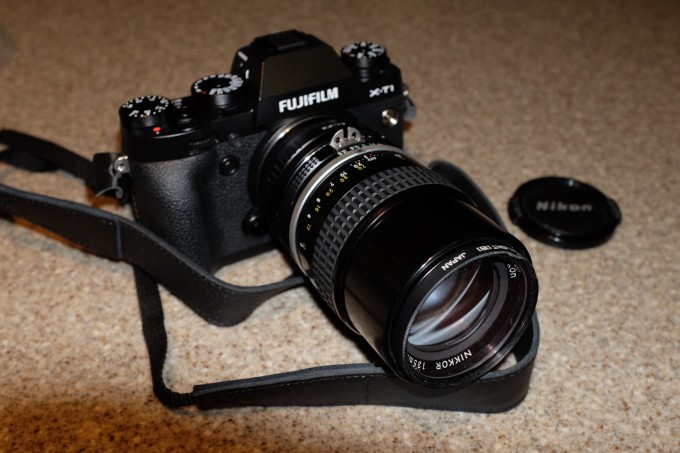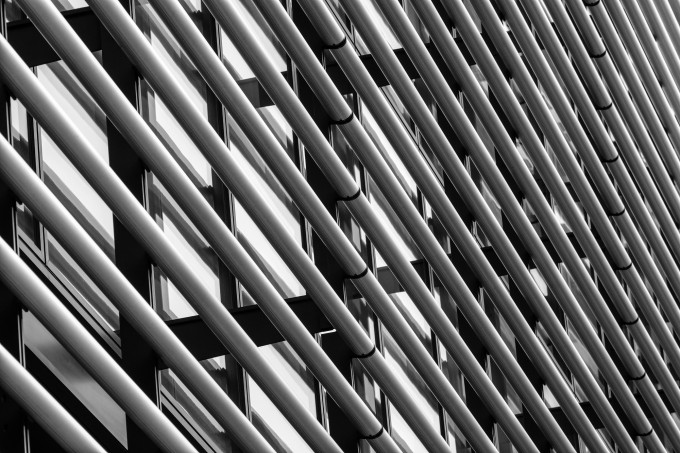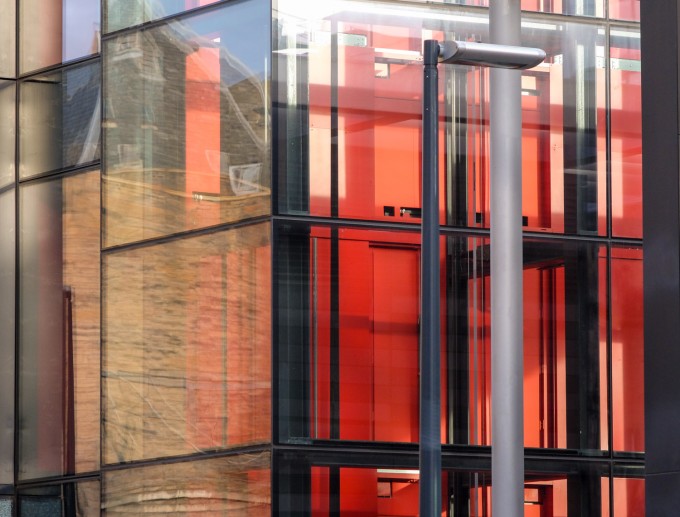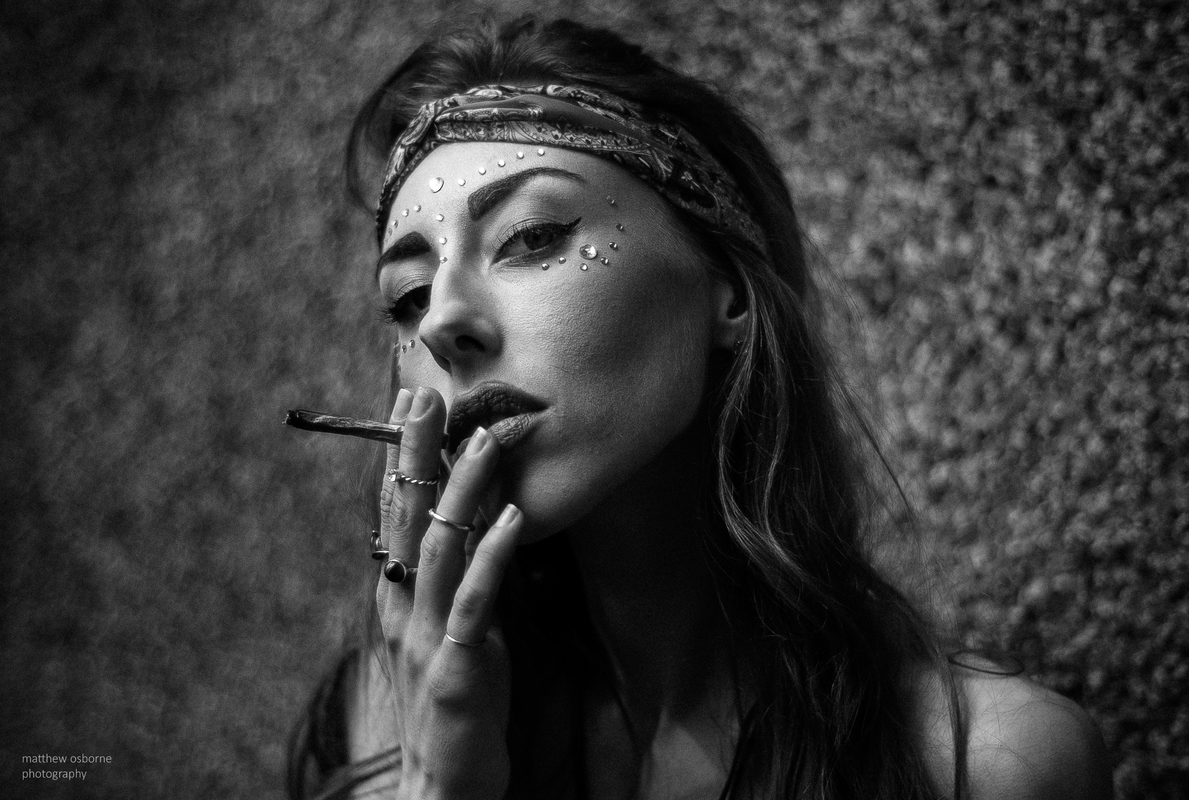The Real Digital FM3? Nikon Manual Lenses on the X-T1
by David Nash
Hi Steve and readers.
Not being as young as many of you I still have a soft spot for small metal cameras with lots of dials (even if I don’t actually turn them) – and a bundle of Nikon lenses including one or 2 old bought cheaply at our local camera shop (yes we still have one in a city of 500,000!). So like many I was desperate to get my hands on the Nikon Df – and I did. But I was a bit underwhelmed and when it had to be returned because of an AF fault I took a refund rather than a replacement.
With the money I got back I’m now the delighted owner of a Nikon 24mm 1.4 and, arriving yesterday, a Fuji X-T1. And it’s definitely not going back…. But being a bit slow on the uptake I hadn’t up till now thought about using Nikon manual lenses on Fuji X cameras (I had an X-E1) and immediately ordered a Nikon fit adapter that arrived this morning. So I spent a couple of hours this afternoon shivering my way round the streets of Edinburgh with my brand new X-T1 and a 135mm f.3.5 Nikon that I picked up for less than £100. As you’ll see in the photo it’s really quite small for a 200mm equivalent focal length – but very solid and well made and quite sharp (though not in the same league as the 90mm Elmarit which I will be trying out next).
Here are few photos of bits of some of our local buildings. What I really enjoyed about using the X-T1 with the manual lens was how well the focus peaking worked (in most circumstances) and how easy it is to magnify the focus area with the focus assist button. You need to focus at max aperture to get the best result but it’s no hassle to stop the lens down a few clicks if you need some depth of field. But what I particularly like about using the X-T1 with a longer lens like is that if I turn the ISO dial to auto (yes I do actually use the dials a little) and the shutter speed to 180th of a second the camera will automatically change the ISO as I (manually) change the shutter. That way I can keep a high enough shutter speed and have complete control over the aperture. Smart! Oh, and I think you all know anyway that the Fuji sensor is rather good at high ISOs. And I did I remember to say the viewfinder is brilliant??
So – as many others seem to be saying – is this not what the Df should have been?
Thanks
David
www.davidnashphotos.co.uk








I don’t get why everyone hates the DF, the layout is almost identical, the sensor is great, same MP of course, and the build quality is better than the xt1 (I own both).
Having owned a Fm3. I doubt it.
They could take a lot of beating, not F3 beating, but a lot.
Manual controls and a small camera isn’t all the FM/F range was about. I doubt an XT1 would like long hauls in sub-zero C temps or being used to stop bullets in war zones.Having used an FM2 to hammer a nail in a wall, I’d love to see the mess that would make of the XT1.
I know size wise and general feel it may get there, but the marque film cameras were so much more than that. I wish we could all come to terms with it too and stop looking back. Ergonomics and usability are ergonomics and usability. Durability and dependability are separate things. Already reports of bad build and light leaks on the XT-1 are surfacing.
Keep in mind Nikon regularly saw F5’s coming in with over 1 million actuations on the shutter with no wear. The Fm’s used similar components. They were field tested to death. To this day nikon’s pro ranges have the same tests undertaken.
I will accept this kind of summation when we see the evidence of the whole picture. The artic trips, the long term use in the field. Until that day we only have a more ergonomically close box with a sensor slapped in it. The M9 made waves for a reason.. as it is as good as the film M’s in build as well as being digital.
I’d also like to add, judging by the durability of Fuji’s film based photographic products. The Xpan / H1 (hasselblads under licence) and the other professional roll film systems. They do not last as well as others.
That level of build – while still amazing – isn’t necesary in this day and age. Pro photographers in a warzone can still hav a brand new replacement sent to them in not much time. And they are available all over the world. As amazing as the build of those old cameras was, we live in a different world now. Sadly ‘build’ is just as much of a status symbol now as everything else Leica or whatever.
No, the XT-1 is absolutely not what the Df should have been. The Df is just fine as it is. I come from many years of using FM2, F3 and the Hasselblad system. The Df feels about the same as an F3 or F2 in the hand rather than the FE or FM series.
If you have Nikkor lenses it makes no sense to buy the XT1.
Short story: The Df is a better camera.
Long story:The Df has a superior optical reflex mirror viewfinder. Reflex mirrors mechanisms is more expensive than the little TV in the XT1 to make, and in my opinion far better to work with. The Df viewfinder has very good contrast and is easy to focus manually. The Df has better build quality than any Fuji. All buttons are much tighter, bigger and of higher quality. The joints and overall fit and finish is higher. Importantly, the Df “flows” much better in use than any Fuji. When reviewing images on the back, entering the menu, et c, the Df is much much faster. All Fuji cameras I have worked with have a short lag in comparison. I have to wait compared to using Nikon or Canon where the camera reacts instantaneously. Using my manual Nikkors on my Df I have full exif data of lens and aperture. I can use any of the metering modes including matrix. As I still use film cameras, the Df has the same layout and the same locks as other classic Nikons – exposure compensation and ISO on the left, “thumb lock” on the ISO. The shutter dial on the Df works the same as on other Nikons – locks on auto, T and X via central lock button. The experience of using the Df is completely consistent with using classic Nikon. The camera controls looks and operate the same. The grip feels like the F3.
The only way the Df could have been as thin as the FM2 would have been to ditch the F-mount. I am extremely happy they didn’t. Now since you have an XT1, take the chance to look at the focal plane symbol and it’s location on the camera. Then look at where the same symbol is marked on your FM. See?
It’s very easy to say something like “the XT1 is the real FM” but when you actually start comparing the two the Df is not only the superior camera but is much more consistent with Nikon design, is fully compatible with Nikon lenses, flash systems, accessories and the rest of the Nikon system. The pictures from the Df shares dimensions and characteristics of 35mm and smokes any Fuji in regards to picture quality. Better colours and dynamic range. So no, the XT1 has nothing to do with the FM whereas the Df not only takes the best from classic Nikon design but in my opinion, and guys like Bjorn Rorslett, improves on the old cameras to a new higher level.
Grey Tor, that’s the most balanced summary of the Df I’ve seen. You’re tempting me to hand in my D800.
I own the Nikon Df and several Fujifilm cameras. I don’t own an XT1; however, I have an Xpro 1–a camera hat uses the same sensor. The Nikon Df simply blows the Xpro 1 out of the water on all counts. While the Xpro 1 is certainly a competent camera, it is, from my experience, ludicrous to suggest that it can keep up with current generation full frame Nikons.
Not unique! The Pentax LX had a far more complete hybrid mechanical/electronic shutter, with a wider range of mechanical shutter speeds (without battery) long before the FM3a. It was also a marginally better camera, with a larger, brighter viewfinder, much better aperture readout, smoother wind on (with bearings) and interchangeable finders. All in the same size package – a dream of a camera. If only it had a FF digital back!
Hi Rob, looked it up and yes, not unique in its hybrid shutter concept. Should have known that…
What I am most impressed with with the FM3a is that Nikon was audacious enough to embark on that project in the very late nineties, when most of the skills, technology and materials of the seventies and early eighties was pensioned off or simply not available anymore. But they pulled it off, and managed to cram that hybrid shutter into the same space as the in effect simpler mechanical shutter of the FM2 or the electronically governed shutter of the FE2.
The Pentax LX has mechanically timed speeds of 1/75 to 1/2000 plus B, and electronic from 125 seconds (!) to 1/2000.
Nikon FM3a has mechanically timed speeds of 1/1 to 1/4000 plus B, and stepless electronic from 8 seconds to 1/4000.
Both represented fantastic no cost cutting engineering. Something sorely missed today.
Back on topic, photo #2 is most excellent.
Best regards
Huss
i fully agree Huss; and #2 for me as well!
David,
I do like the pictures both in terms of composition and colours. The old Nikkors are doing pretty well as always. I am wondering though why you were ovewhelmed by the Df. You should have your personal reasons but Df is a top FF DSLR matched with all MF Nikkors in a way no other Nikon DSLR has been so far. I am just wondering.
Regards,
Dimitris V. Georgopoulos
Photographer at Large
Athens, Greece
I just wonder what the Fuji gives you better than the Nikon DF when you use it with Nikon lenses?
The DF has faster AF, a fullframe sensor (means you can use the Nikon lenses with the FOV they were designed for), muc better high iso and DR?
I can see the Fuji makes sense when you want small lenses, but why would you use that body for Nikon lenses???
The FM3a film camera was distinguished among other things by its format (full frame 135), by its reflex viewing, by its ability to shoot forever without a battery, and was relatively compact. The chatter for a digital version was around these traits.
The wonderful Fuji delivers none of these features, other than the relatively compactness, but of course the Fuji is not unique in its dimensions.
The FM3a has one more trait that, as far as I know, is unique: its hybrid shutter, combining both electronic and fully mechanical operation. In addition, that whole assembly had to be “invented” early in the new millennium (the skills to do that had almost evaporated), and had to fit into the classic compact F envelope. An engineering feat of staggering proportions, when you think about it. I don’t think full frame digital can be replicated in that same envelope, unfortunately.
Not unique! The Pentax LX had a far more complete hybrid mechanical/electronic shutter, with a wider range of mechanical shutter speeds (without battery) long before the FM3a. It was also a marginally better camera, with a larger, brighter viewfinder, much better aperture readout, smoother wind on (with bearings) and interchangeable finders. All in the same size package – a dream of a camera. If only it had a FF digital back!
I didn’t know that Rob. Was it in effect two shutter mechanisms, like the FM3a? I’ll look into the LX!
I’ve been shooting with Fuji X three years now, first X100, then X-Pro1. Every Fuji has been hyped to be a ‘mythical camera’. To me they are not. I have really hoped they were when I bought myself into this system, but Fuji loves the culture of releasing unfinished products and never solving the core problems this system has, unfortunately. After 2 years there is still not an artifact-free conversion possible of the X-Trans RAWs, is that professionalism? Is that even a problem we can accept from a ‘mythical camera’? I also find all this X-stuff to be very cheap finished, delicate, finished not very resistive paint and plastic. I had two broken lenses, guarantee issues, but that story was less easy to solve with the Fuji after sales services than it appeared. The dozen FW releases have been nothing short of a kind of damage control to get this – at the beginning very poor – system working as 99,99% of the high-end camera-market would expect. It surprises me that so many are really putting this system on a pedestal it doesn’t deserve at all. Oh yes, the image quality. It stands? What about the mushy green, color bleeding and ‘wrong color pixels’ that completely mess up certain areas under completely unpredictable circumstances? If Fuji ever releases an X-Pro2 with a FF sensor and a normal Bayer-CFA, I might be interested again but I won’t be a first wave buyer of any Fuji camera, NEVER AGAIN.
I agree and also do not agree with you. I can anticipate some of your feelings but it seems that the truth is somewhwere amidst. My experience is with the X-E1, I therefore cannot commend on other Fuji’s bodies. There are issues with the X-Trans sensor when Lightroom 4 and 5 are used. Capture One Pro 7 of Phase One delivers excellent RAW conversion and colour editing for Fuji files. Neither X-E1 nor other Fuji’s bodies that happenned to evaluate are somethhing exceptional quality wise but I think they are sufficient for the job. The EVF definetely is not their strongest point especially if they are compared against Sony 7. At least the M adapter works well. The match with the Nikkors is good enough. The unexpected colour aberrations and shades under critical lighting conditions or available light are indeed a problem rather difficult to be adressed even with very careful post processing. Overall Fuji, to the best of my limited experience, cannot much the Df’s capabilities not Canon’s and cannot match the Leica M in overall colour quality. But something that must not go un-noticed is the price. Fuji can deliver a high quality in its class, can accept nearly every lens around, it is small in size and costs at least half the price of its FF competitors. This is a solid fact that can accomodate thousands of photograhers around the globe.
Regards,
Dimitris V. Georgopoulos
Photographer at Large
Athens, Greece
This is a harsh review. However, it is one with which I largely sympathize. I think that EJPB overstates the case when he talks about the general quality of Fuji cameras. But his comments regarding the Xtrans sensor and the hype that goes along with it are, I think, spot on. I have been shooting Fujifilm cameras for the past three years. And I still own three- the X100, X100s, and Xpro 1. The X100 (with its bayer CFA) is the only one that gets regular use. The reason for this is the Xtrans sensor. Though I have switched to Capture One Pro 7, I am still confronted by strange artifacts that I don’t know how to deal with. And then there are the jpegs. It is now well known that all Xtrans sensor cameras have a tendency to smear skin tones under certain conditions. (The X100s appears to be the worst offender here.) But my question is this: Why all this hype with a sensor that offers *no real advantage* over bayer CFA sensors? Virtually every claim about the ‘revolutionary’ nature of the Xtrans sensor has been proved false. To name them: it isn’t any sharper than other sensors that have dropped the AA filter; it doesn’t deal with moire any better than those sensors. ‘Film-like’ noise patterns? This claim is easily refuted. But what about the high iso advantage of Xtrans’? It is well established that Fujifilm has overstated their cameras’ iso capabilities. And some believe that whatever advantage Fuji cameras do have appear to be the result of ‘cooking’ the raw files before they are stored. I don’t know whether this is true. However, Fuji has, to my thinking, backed itself into a corner with Xtrans. It would be difficult for them to now admit that they made a mistake and simply return to the bayer CFA. While I love my original X100, I will not be buying another Fuji camera so long as the Xtrans sensor is around.
A comment on my comment: Smeared skin tones in jpegs has nothing to do with the Xtrans sensor. I should have said Xtrans cameras. This is the result of Fuji’s in camera jpeg conversion.
+1 – and I don’t understand why the market accepts this kind of problems. ALL raw convertors show artifacts, some less, some more, btw. – the concept is just wrong.
I think they inadvertently proved the point to some degree by releasing the XA1 with a standard Bayer sensor, and a very good one! I’m sure plenty of people have seen the endless squabbling over whether the XA1 is “better” than the other entry level X-trans camera, the XM1, but I bought the XA1 (which I still consider over-priced) and the picture quality really does raise questions over the X-trans sensors supposed superiority.
All I can say is that I am getting razor sharp, yet smooth as silk jpegs OOC, and easily workable RAW files at any ISO with a good prime, and despite some other issues (price, build, focusing) it’s become my favourite camera, just due to results.
David, can you shoot the X-T1 in aperture priority with the 135mm and other manual lenses?
NIce work. The X-Pro 1 would not handle the longer lens like the X-T1. I use my Leica APO 90mm F2.0 ASPH, it is like a 135mm on full frame. An other great Nikkon MF lens is the 105 F2.5, it is one best lens I have ever used.It would be 150mm lens.
David,
I’ve always been swayed by architectural photography, and I find you images very appealing. Pity you submitted only three, when I see other postings on Steve’s site with far more.
TerryB,
You can go to David’s own site and see many more pictures.
http://www.davidnashphotos.co.uk
Hans,
Thank you for pointing out David’s link, which I confess I missed!
If you are really into Nikon lenses of the X-T1, maybe you should get a lens turbo/metabones speed booster, so you can maintain the focal length, and get a speed boost
Lovely geometrics there David. Like you (and having a D800 with four 1.4 primes, an F2AS, an FM2n, an FE2 and an FM3a, with a number of Ai and AiS primes) I was underwhelmed by the Df. But I don’t think I want to get used to an EVF, nor go back to the DX format. Once full frame, it’s stuck in my mind and eyes. makes switching between digital and film, and switching lenses around easy as well.
But I must admit, I saw and handled the X-T1 in my local camera shop (yes, Amsterdam has several) and was, apart from the EVF, immediately attracted!
Great lines and form! I particularly like the second photo. Similarly to your own thinking, nothing made me want to shoot with Fuji more than the Nikon Df. I have a set of old manual focus Nikon lenses that are now regularly attached to the Fuji with a Speed Booster and I’ve been having a blast.
I had a very similar experience, only with the EM-1 I honestly did not like the camera, I got the XT-1 and I will never go to another system, it will last me a very long time, the whole experience has been a revelation. Ive been interested in manual glass, so this is very interesting to me.